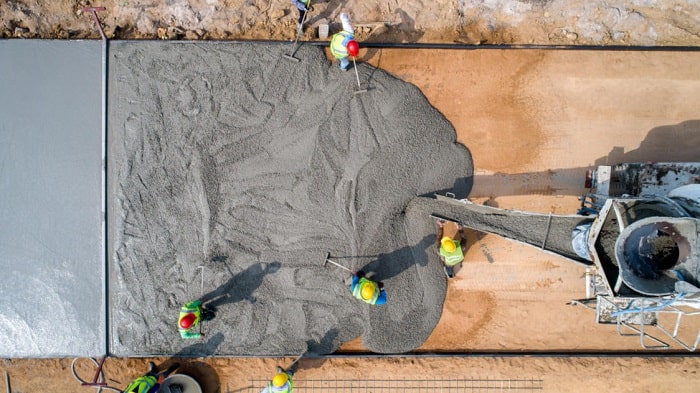ConcreteZero – Constructing A Data-Driven And Net-Zero Path
There is no doubt whatsoever that data happens to hold the key to change. And there is no industry that’s better placed to take advantage of this transformative change than concrete. With the production as well as use of concrete accounting for 7% of worldwide greenhouse gas emissions, decarbonization happens to be rapidly turning into […] The post ConcreteZero – Constructing A Data-Driven And Net-Zero Path appeared first on World Construction Today.

There is no doubt whatsoever that data happens to hold the key to change. And there is no industry that’s better placed to take advantage of this transformative change than concrete. With the production as well as use of concrete accounting for 7% of worldwide greenhouse gas emissions, decarbonization happens to be rapidly turning into the sector’s priority. Businesses across the world, including the ConcreteZero members, are indeed committed to mitigating the carbon footprint of their respective concrete supply chains. But the question arises as to how the companies can precisely pinpoint where the emissions go on to occur in their value chain and, thereafter, when and where they should go ahead and take a decisive step?
This is where data accuracy, ownership, and transparency go on to play quite a pivotal role when it comes to driving the concrete sector towards a future that’s net zero.
Going past the intricate supply chains
It is well to be noted that concrete supply chains happen to be complex and span numerous stages, right from raw material extraction to the last product that is made and used in construction. Concrete, which is the finished material, happens to be made up of many ingredients, all of which have their own supply chains as well as emissions. Furthermore, exact data around business-level concrete use as well as concrete mix carbon intensity is not available readily at all times because of a dearth of communication throughout the value chain. Contractors as well as contract engineers don’t always interact with each other.
This goes on to imply a level of complexity when evaluating the usage of concrete as well as the emissions it tags itself with. But attaining transparency surrounding this data is critical. By way of unlocking the potential when it comes to corporate leadership, one can indeed give throttle to a net zero transition within the concrete sector.
One can only reduce what is measured by way of best practices. The work that is at present taking place with ConcreteZero members happens to be a testimony to this principle. Through aiming to put forth data transparency throughout the sector, supporting businesses in their respective decarbonization endeavors holds the key.
Starting ConcreteZero reporting
It is worth noting that ConcreteZero needs members to go ahead and commit to 100% usage of net zero concrete by 2050, in addition to using lower emission concrete with an interim commitment of 50% by 2030 and 30% by 2025. Hence, reporting with these commitments in mind is very critical for effectively monitoring progress and, at the same time, making informed decisions, thereby helping with decarbonization endeavors.
In 2023, members were asked to measure as well as report their emissions for the first time in history, and this went on to mark a global step when it came to reporting standardization and also enhanced flows in terms of information throughout the market. In order to be a part of the reporting trial, members had to review their respective concrete purchases, source data on the quantity of concrete they used, and most importantly, ask for emissions data from the suppliers. All this was indeed a phenomenal first step.
It is a great beginning; now on to the next step
So what were the insights that this first absolute reporting phase rolled out?
Well, the first was that the data exists, but benchmark sector practices with regards to its collection as well as information all through the value chain could well be lacking. One requires businesses to project a unified commitment so as to sturdily and consistently evaluate this data and to acknowledge its vital role when it comes to driving the mandatory decarbonization alteration. The next step happens to be embedding these best practices in the organization and thereafter extending them all across the value chain.
So, what is the role of ConcreteZero in this?
The members are helped to examine systematically the information, lay out minimum standards, and collectively go ahead and establish as well as apply rules of engagement. Through establishing parameters as well as a methodology and a framework, a new standard for best practice is being set.
Going beyond transparency – Setting sector benchmarks
The fact is that the raw power of data goes beyond the gamut of transparency just for the sake of it. It goes on to signal a very stark market shift for its producers. Continuous as well as collaborative monitoring, reporting, as well as measuring can go on to lead to real alterations when it comes to the concrete supply chains. Through establishing standards as well as frameworks when it comes to data disclosure, the path to attaining transparency and decarbonizing the sector is attained.
Interestingly, ConcreteZero members happen to be advocating for entire emissions data transparency and also defining supplier needs so as to meet up with their goals simultaneously.
Sector-wide alignment in terms of procurement needs, supplier data, as well as definitions is very critical, and the reporting helps with this.
This kind of shared understanding is going to drive focused as well as timely action, thereby helping the worldwide concrete sector’s decarbonization.
The fact is that the reporting framework not only informs transparency but at the same time also validates a wider market performance as well underscores business choices. This data is indeed required to optimize the performance of the present solutions that are available and, at the same time, design strategies so as to attain maximum reduction when it comes to emissions.
Leading the decarbonization charge
Concrete Zero members happen to be leading and are committed to lessening emissions and also giving out decarbonization leadership. Due to many leading businesses committed to reporting necessary data, the first step is taken to increase the data transparency and make much more informed decisions.
There are also barriers that need to be looked into so as to decarbonize the sector further. Going past these challenges as well as creating frames of reference that are in sync are going to be instrumental in driving fast transformation in the sector. The fact is that ConcreteZero helps foster partnerships all through the concrete value chains, which will go on to lead to an industry change that’s very transformative.
The post ConcreteZero – Constructing A Data-Driven And Net-Zero Path appeared first on World Construction Today.

 machineryasia
machineryasia 






